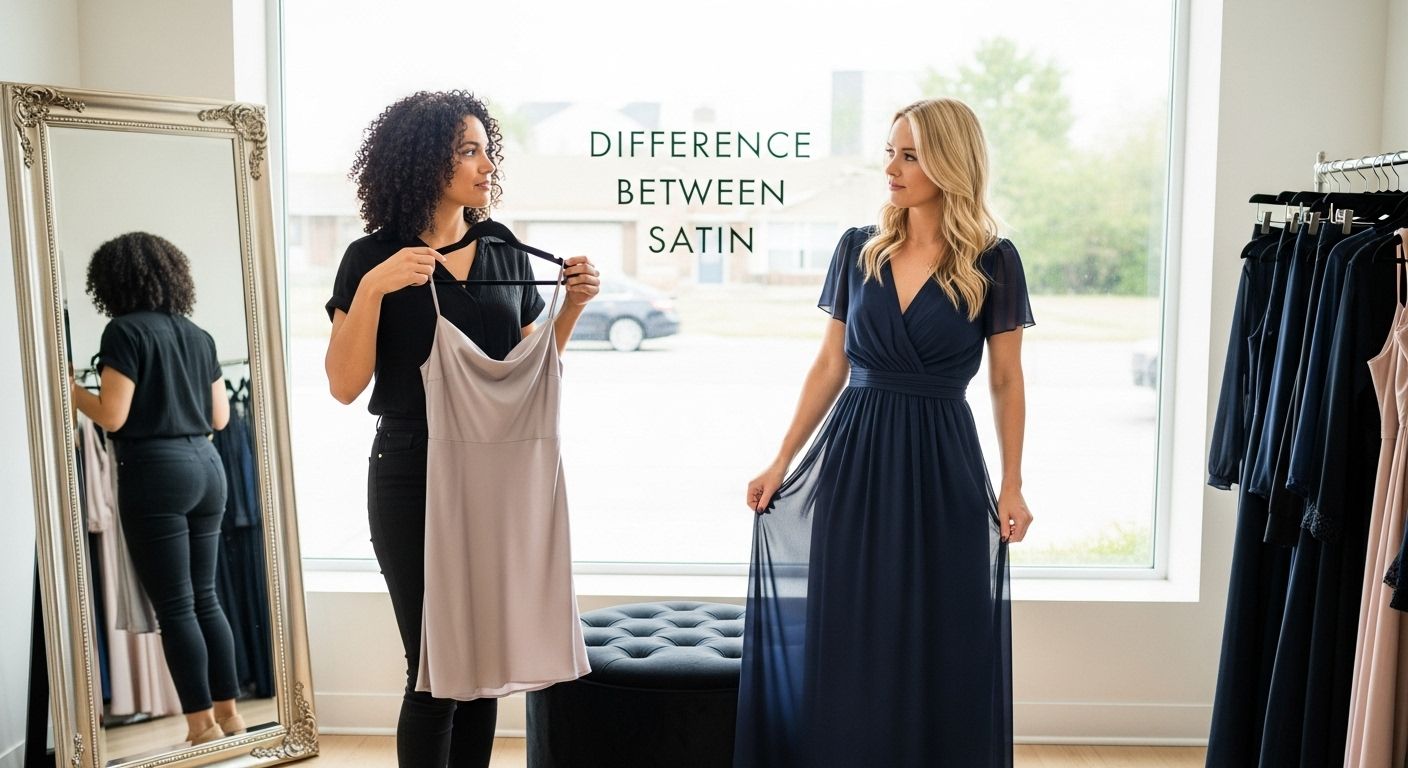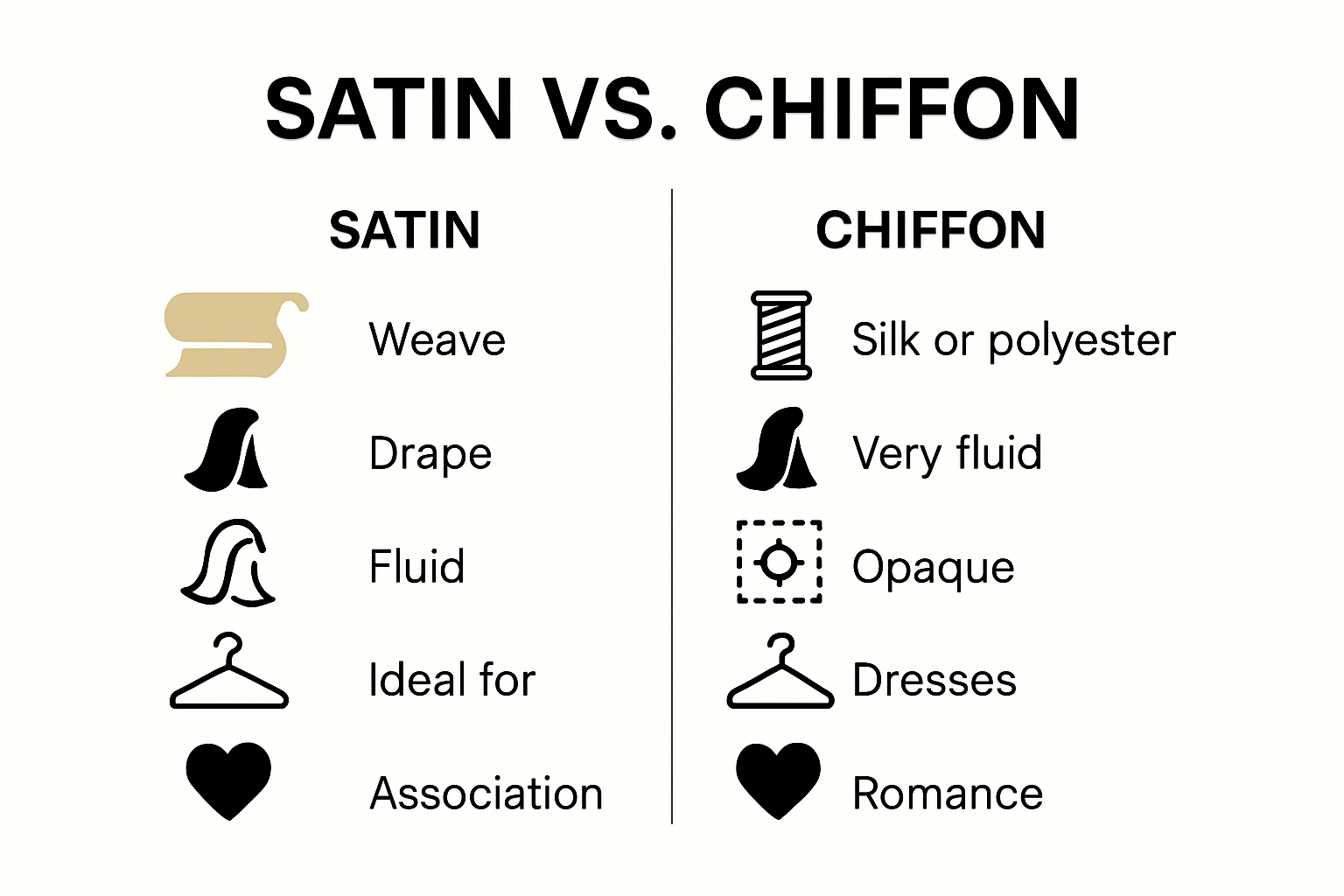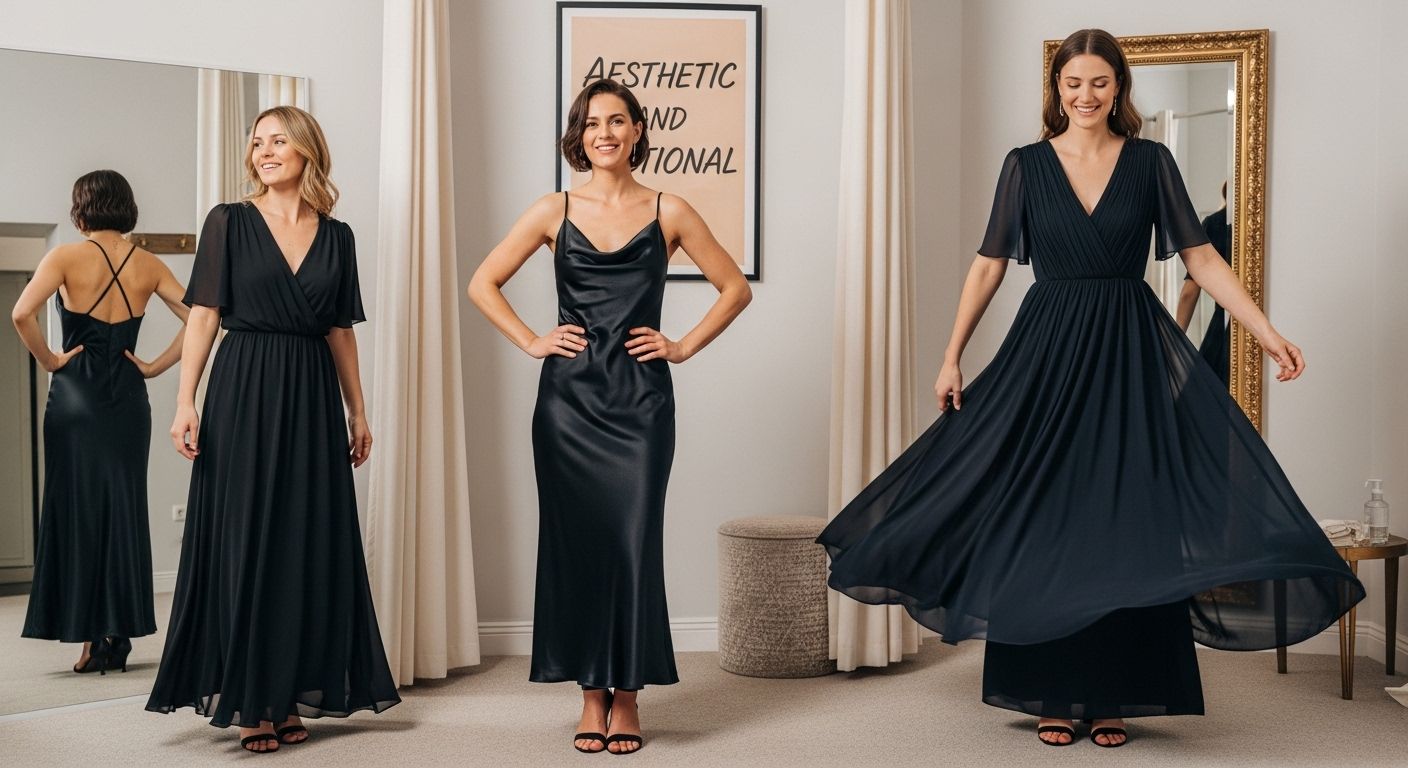Understanding the Difference Between Satin and Chiffon
Understanding the Difference Between Satin and Chiffon
Choosing between satin and chiffon sounds simple, right? Both fabrics show up in cocktail dresses, wedding gowns, and red carpet looks everywhere. But surprisingly, the real difference runs deeper than just looks and feel. Satin owes its glossy surface to a unique weaving technique, while chiffon is known for its remarkable lightness and transparency. This means your pick could completely shift how you move, how you feel, and how everyone sees you before you say a word.

Table of Contents
- Defining Satin And Chiffon: Key Characteristics
- The Importance Of Fabric Choice For Special Occasions
- Exploring The Properties Of Satin: Texture And Shine
- Unveiling Chiffon: Lightweight And Flowing Qualities
- Choosing The Right Fabric For Your Event: Satin Vs Chiffon
Quick Summary
| Takeaway | Explanation |
|---|---|
| Satin features a glossy, smooth surface | Satin’s unique weaving technique allows it to have a reflective finish, enhancing its luxurious appearance. |
| Chiffon is lightweight and transparent | Chiffon is crafted from delicate fibers, giving it a soft, flowing quality that is ideal for layered designs. |
| Choose fabric based on event type | Consider factors like venue temperature, dress code, and movement needs when selecting fabric for special occasions. |
| Satin conveys elegance; chiffon suggests romance | The reflective quality of satin suits formal events, while chiffon’s ethereal nature is best for romantic settings. |
| Fabric choice impacts confidence and presentation | Selecting the right material not only affects aesthetics but also influences how you feel throughout the event. |

Defining Satin and Chiffon: Key Characteristics
When exploring the difference between satin and chiffon, understanding their fundamental characteristics becomes crucial for anyone interested in fashion and textile selection. These two fabrics might seem similar at first glance, but they possess unique properties that dramatically impact their appearance, functionality, and appropriate usage in clothing design.
Fabric Composition and Weaving Techniques
Satin and chiffon differ significantly in their manufacturing processes and underlying structural composition. Satin is defined by a specific weaving technique that creates a glossy, smooth surface with a distinctive sheen. According to Encyclopedia Britannica, traditional satin historically originated from silk but can now be produced using various synthetic and natural fibers like polyester, nylon, and rayon.
Chiffon, by contrast, represents a lightweight, transparent fabric characterized by its extremely fine, delicate weave. The word “chiffon” actually derives from the French term meaning “cloth” or “rag”. Its signature translucent quality comes from tightly twisted yarns woven in a plain weave pattern, creating a slightly rough texture that allows light to pass through.
Visual and Tactile Characteristics
The visual and tactile differences between satin and chiffon are profound and impact their respective applications in fashion design. Satin exhibits a luxurious, reflective surface that catches light and creates a glamorous, smooth appearance. Its surface ranges from high-gloss to more subdued sheens depending on the specific fiber and weaving technique used.
To help you easily compare the fundamental differences between satin and chiffon, here is a side-by-side comparison of their composition, weave, appearance, feel, and best uses:
| Feature | Satin | Chiffon |
|---|---|---|
| Typical Fibers | Silk, polyester, nylon, rayon | Silk, polyester, nylon |
| Weave Technique | Satin weave (creates smooth, glossy surface) | Plain weave with tightly twisted yarns |
| Appearance | Glossy, reflective, luxurious | Sheer, lightweight, transparent |
| Texture/Feel | Smooth, cool to the touch | Slightly rough, soft, airy |
| Best For | Formal/evening wear, structured gowns, cocktail dresses | Flowing, layered designs, romantic or summery looks |
| Drape & Movement | Structured drape, enhances formality | Flowy, moves freely with body |
| Coverage | Opaque or semi-opaque depending on thickness | Highly transparent, typically layered |
Chiffon, meanwhile, presents a completely different aesthetic. Its lightweight, ethereal nature makes it ideal for creating flowing, romantic garments. The fabric has a soft, slightly rough texture that provides a graceful drape and movement, making it perfect for layered designs, evening gowns, and delicate accessories.
Understanding these fundamental differences allows fashion enthusiasts and designers to select the most appropriate fabric for specific clothing designs, ensuring both aesthetic appeal and functional performance.
The Importance of Fabric Choice for Special Occasions
Selecting the right fabric is a critical decision that transforms an ordinary outfit into an extraordinary ensemble. When attending formal events like weddings, proms, or galas, the fabric you choose can dramatically influence your overall appearance, comfort, and confidence. The distinction between satin and chiffon becomes particularly significant in these high-stakes fashion moments.
The following table outlines key factors to consider when choosing between satin and chiffon for special occasions, summarizing both technical and emotional performance:
| Factor | Satin | Chiffon |
|---|---|---|
| Drape & Movement | Structured, enhances polished look | Flowing, creates dynamic silhouettes |
| Temperature Suitability | Good for cooler indoor events | Breathable, ideal for warm/outdoor settings |
| Formality Level | High formality (black-tie, galas) | Versatile, often for romantic or casual events |
| Confidence Impact | Conveys elegance, sophistication | Feels romantic, airy, light |
| Layering Needs | Usually worn as a single layer | Frequently layered due to transparency |
| Maintenance | Can be durable (esp. synthetics); may show marks | Delicate, prone to snags, requires care |
Event Appropriateness and Fabric Performance
Fabric selection goes far beyond aesthetic appeal. According to research from the Textile Society of America, the technical properties of a fabric directly impact its performance during special occasions. Different events demand specific textile characteristics that can make or break your outfit’s success.
Consider the following critical fabric considerations:
- Drape and Movement: How the fabric falls and moves with your body
- Transparency and Coverage: Level of see-through quality and comfort
- Temperature Regulation: Breathability and comfort in different event environments
- Durability: Ability to maintain appearance throughout the event
Emotional and Psychological Impact of Fabric Choice
Beyond technical specifications, fabric choice carries profound emotional significance. The right material can boost confidence, create memorable impressions, and help you feel perfectly attuned to the event’s atmosphere. A carefully selected dress communicates not just style, but personal narrative and understanding of social nuances.
Whether you opt for the luxurious shimmer of satin or the ethereal lightness of chiffon, your fabric tells a story. Satin communicates elegance and sophistication, perfect for formal evening events, while chiffon suggests romantic, soft femininity ideal for summer weddings or garden parties.
Understanding these subtle yet powerful fabric dynamics empowers you to make informed fashion choices that elevate your entire special occasion experience.
Exploring the Properties of Satin: Texture and Shine
Satin represents a remarkable fabric that transcends ordinary textile expectations, offering a unique combination of visual drama and tactile elegance. Its distinctive properties make it a standout choice for those seeking to create memorable fashion statements across various special occasion settings.
Surface Characteristics and Light Interaction
Satin’s most remarkable feature is its extraordinary surface reflectivity. Unlike other fabrics, satin creates a mesmerizing visual effect through its unique weaving technique that allows maximum light reflection. According to textile research, the characteristic sheen emerges from long floating yarns that create a smooth, uninterrupted surface capable of capturing and bouncing light in stunning ways.
The fabric’s surface can be categorized into different shine levels:
- High Gloss: Extremely reflective, mirror-like appearance
- Medium Sheen: Subtle luminosity with soft light reflection
- Subdued Shine: Minimal reflectivity, more muted elegance
Textural Complexity and Sensory Experience
Satin’s texture is a sophisticated interplay between smoothness and structural complexity. While appearing uniformly sleek, the fabric actually contains intricate weaving patterns that contribute to its unique feel. The surface simultaneously feels cool to the touch and incredibly smooth, creating a sensory experience that sets it apart from other materials.
Fabric weight and fiber composition significantly influence satin’s tactile qualities. Silk satins offer a lightweight, almost fluid sensation, while polyester satins provide more structure and durability. These variations allow designers to select satin for diverse dress styles ranging from flowing evening gowns to structured cocktail dresses.
Understanding satin’s nuanced properties empowers fashion enthusiasts to make sophisticated fabric selections that elevate their entire outfit’s aesthetic and emotional impact.
Unveiling Chiffon: Lightweight and Flowing Qualities
Chiffon represents the epitome of ethereal elegance, embodying a fabric that transcends mere textile and becomes an artistic expression of movement and delicacy. Its unique characteristics make it a preferred choice for designers seeking to create garments that capture grace, sophistication, and subtle sensuality.
Structural Composition and Translucency
Chiffon’s defining characteristic is its remarkable lightness and transparency. According to Ohio State University’s textile research, chiffon is typically composed of fine silk, polyester, or nylon fibers meticulously woven to create an incredibly lightweight, sheer material. The fabric’s signature look emerges from a unique plain weave technique that produces a slightly rough, textured surface.
Key structural elements of chiffon include:
- Fine Yarn Twisting: Creates subtle texture and slight opacity
- Balanced Weave: Ensures consistent transparency
- Minimal Fiber Thickness: Contributes to exceptional lightweight quality
Performance and Aesthetic Dynamics
Chiffon’s performance extends far beyond its visual appeal. The fabric’s exceptional draping capabilities allow it to create fluid, dynamic silhouettes that seem to dance with the wearer’s movements. Its inherent characteristics make it ideal for layered and romantic dress designs that require depth, dimension, and visual intrigue.
The fabric’s versatility shines through in its ability to adapt to various garment styles. From delicate evening gowns to elegant scarves, chiffon transforms based on the designer’s creative vision. Its semi-transparent nature allows for strategic layering, creating visual depth and intricate aesthetic effects that more rigid fabrics cannot achieve.
Mastering chiffon’s unique properties requires an understanding of its delicate nature, enabling fashion enthusiasts to harness its transformative potential in creating truly memorable ensembles.
Choosing the Right Fabric for Your Event: Satin vs Chiffon
Selecting the perfect fabric is a nuanced art that can dramatically transform your entire event appearance. The choice between satin and chiffon extends far beyond simple aesthetic preferences, involving complex considerations of event type, personal style, comfort, and desired visual impact.
Event Context and Fabric Performance
Understanding your event’s specific requirements is crucial when deciding between satin and chiffon. According to textile research, fabric selection involves evaluating multiple performance characteristics that directly influence your overall comfort and presentation.
Key event considerations include:
- Venue Temperature: Indoor versus outdoor environment
- Dress Code: Formal, semi-formal, or casual settings
- Time of Day: Daytime elegance or evening glamour
- Personal Movement Requirements: Dancing, sitting, standing
Aesthetic and Emotional Resonance
Each fabric communicates a unique emotional narrative. Satin signals sophisticated glamour with its reflective surface and structured silhouette, making it ideal for black-tie galas and winter weddings. Chiffon, conversely, suggests romantic softness, perfect for spring garden parties, beach weddings, and events requiring ethereal, flowing movement.
The fabric’s psychological impact cannot be understated. A carefully chosen dress becomes an extension of your personal expression, helping you feel confident and perfectly aligned with the event’s atmosphere.

Ultimately, fabric selection is a personal journey of balancing technical performance with emotional resonance, ensuring you look and feel extraordinary in any special occasion setting.
Find Your Perfect Dress: Satin and Chiffon Styles for Every Special Event
Struggling to choose between the luxurious shine of satin and the effortless flow of chiffon for your next big occasion? The difference is more than just fabric. The right choice can impact your comfort, confidence, and the way you are remembered at any celebration. Whether you want the glamour and structure of satin or prefer the airy, romantic feel of chiffon, Dress Me Up NY brings your vision to life with a curated collection of beautiful designer dresses to match your style and needs.

Now is the perfect time to discover your ideal formal look. Shop our latest arrivals of satin and chiffon dresses and let our detailed catalog and customer-first features guide you with ease. Upgrade your wardrobe and make your next event truly unforgettable. Visit Dress Me Up NY to browse our exclusive women’s special occasion designs and take advantage of our current offers and free shipping deals before they end.
Frequently Asked Questions
What is the main difference between satin and chiffon?
Satin is known for its glossy, smooth surface created by a specific weaving technique, typically resulting in a luxurious appearance. Chiffon, on the other hand, is a lightweight, transparent fabric with a slightly rough texture, ideal for flowing designs and layering.
When should I choose satin over chiffon for an outfit?
Choose satin for formal events where a sophisticated and glamorous look is desired, such as black-tie receptions or evening galas. Opt for chiffon when you want a lighter, more ethereal feel, suitable for occasions like summer weddings or outdoor garden parties.
How do the draping qualities of satin and chiffon compare?
Satin has a structured drape that enhances the luxury of garments, making it ideal for form-fitting or elegant designs. Chiffon provides a soft, flowing drape that allows for dynamic movement, perfect for layered looks and romantic silhouettes.
Can satin and chiffon be used together in a single outfit?
Yes, satin and chiffon can complement each other beautifully in a single design. Combining the structured elegance of satin with the airy lightness of chiffon can create stunning contrasts and add depth to an outfit.
Recommended
- Terani Couture 2021E2824 Asymmetric Neck One-Shoulder Dress
- Terani Couture 251P4002 Embroidered Tulle Strapless Dress
- Clarisse 5108 Embroidered Sheer Bodice Strapless A-line Gown
- Clarisse 810297 Stunning Seqiun Deep V-neck Ball Gown

